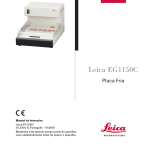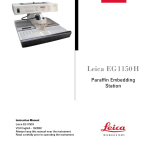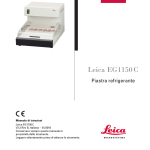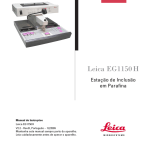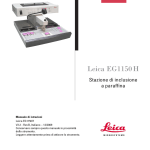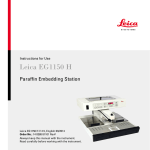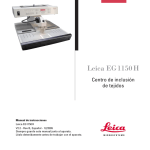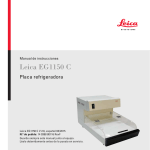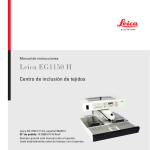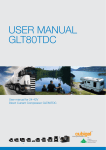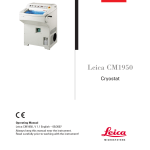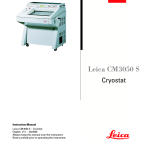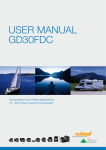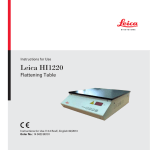Download Leica EG1150 C
Transcript
Leica EG1150 C Cold Plate Instruction Manual Leica EG1150 C V2.0 English – 01/2003 Always keep this manual near the instrument. Read carefully prior to operating the instrument. IMPORTANT NOTE The information, numerical data, notes and value judgments contained in this manual represent the current state of scientific knowledge and state-ofthe-art technology as we understand it following thorough investigation in this field. We are under no obligation to update the present manual periodically and on an ongoing basis according to the latest technical developments, nor to provide our customers with additional copies, updates etc. of this manual. For erroneous statements, drawings, technical illustrations etc. contained in this manual we exclude liability as far as permissible according to the national legal system applicable in each individual case. In particular, no liability whatsoever is accepted for any financial loss or consequential damage caused by or related to compliance with statements or other information in this manual. Statements, drawings, illustrations and other information as regards contents or technical details of the present manual are not to be considered as warranted characteristics of our products. These are determined only by the contract provisions agreed between ourselves and our customers. Leica reserves the right to change technical specifications as well as manufacturing processes without prior notice. Only in this way is it possible to continuously improve the technology and manufacturing techniques used in our products. This document is protected under copyright laws. Any copyrights of this document are retained by Leica Microsystems Nussloch GmbH. Any reproduction of text and illustrations (or of any parts thereof) by means of print, photocopy, microfiche, web cam or other methods – including any electronic systems and media – requires express prior permission in writing by Leica Microsystems Nussloch GmbH. For the instrument serial number and year of manufacture, please refer to the name plate at the back of the instrument. © Leica Microsystems Nussloch GmbH Issued by: Leica Microsystems Nussloch GmbH Heidelberger Str. 17 - 19 D-69226 Nussloch Germany Phone: +49 (0)6224 143-0 Fax: +49 (0)6224 143-200 Internet: http://www.histo-solutions.com Leica EG 115 0 C 3 Table of contents 1. Important notes ............................................................................................................................................. 5 1.1 Symbols used in the text and their meanings .................................................................................. 5 1.2 User group ............................................................................................................................................. 5 1.3 Specified use and application ............................................................................................................ 5 1.4 Instrument type ..................................................................................................................................... 5 2. Safety .............................................................................................................................................................. 6 2.1 Safety regulations ................................................................................................................................. 6 2.2 Safety instructions ............................................................................................................................... 6 2.3 Built-in safety devices ......................................................................................................................... 7 3. Instrument components and specifications ............................................................................................ 8 3.1 Overview – instrument parts ............................................................................................................... 8 3.2 Technical data ....................................................................................................................................... 9 4. Commissioning ........................................................................................................................................... 10 4.1 Location conditions ............................................................................................................................ 10 4.2 Delivery range ..................................................................................................................................... 10 4.3 Unpacking and installing ................................................................................................................... 11 4.4 Power supply ....................................................................................................................................... 12 5. Operation ...................................................................................................................................................... 5.1 Switch on the instrument .................................................................................................................. 5.2 Replacing the secondary fuse .......................................................................................................... 5.3 Malfunctions ....................................................................................................................................... 13 13 13 14 6. Cleaning and maintenance ....................................................................................................................... 15 6.1 Cleaning the instrument ..................................................................................................................... 15 6.2 Maintenance instructions ................................................................................................................. 15 7. Warranty and service ................................................................................................................................ 16 4 Instruction Manual V 2.0 – 01/2003 1. Important notes 1.1 Symbols used in the text and their meanings Warnings and cautions appear in a gray box and are marked by a warning triangle . 1.3 Specified use and application The Leica EG1150 C is a cold plate for chilling and blocking out histological tissue samples in paraffin blocks. Any other use of the instrument will be considered as improper use! Notes, i.e. important information for the user, appear in a gray box and are marked with the symbol . 1.4 Instrument type (5) Figures in brackets refer to item numbers in figures. All information in this instruction manual applies only to the instrument type indicated on the title page. A name plate with the serial number is attached to the back of the instrument. 1.2 User group • The Leica EG1150 C may only be operated by qualified personnel. • The user must read the operating instructions supplied and be familiar with all the instrument’s technical details before any work on the instrument can be carried out. Fig. 1 Leica EG 115 0 C 5 2. Safety Please pay particular attention to the safety regulations and safety instructions in this section. Please also read this information, even if you are familiar with handling and using a Leica instrument. 2.1 Safety regulations This instruction manual contains important instructions and information regarding the operational safety and maintenance of the instrument. The instruction manual is an important part of the product. It must be read carefully before using the instrument for the first time and always kept near the instrument. It may be necessary to add appropriate instructions to this instruction manual, if required by existing national regulations on accident prevention or environmental protection in the country of the operating authority. This instrument was built and tested in accordance with the safety regulations for electrical measuring, control, regulating and laboratory devices as specified below: • EN 61010-1 • EN 61326-1 • EN 61010-2 • EN 61010-10 • EN 61000-3-2 • EN 61000-3-3. In order to maintain this condition and ensure safe operation, the operator must observe all the instructions and warnings contained in this instruction manual. The protective devices on the instrument and its accessories must not be removed or modified. The instrument may only be opened and repaired by authorized Leica servicing technicians. 2.2 Safety instructions The safety devices provided on this instrument by the manufacturer only constitute the basis for protection against accidents. The main responsibility for accident prevention while using the instrument rests with the employer where the instrument is operated, and with the persons he appoints for operating, servicing or cleaning the instrument. To ensure a safe operation of the instrument at all times, the following instructions and warnings should be observed. 6 Instruction Manual V 2.0 – 01/2003 2. Safety Safety instructions – safety regulations on the instrument itself • This device may only be used by trained laboratory technicians. It may only be used according to its intended use and the instructions in this instruction manual. • Safety regulations marked with a warning triangle on the instrument itself mean that when operating or exchanging respective parts of the instrument, the correct operating steps as described in the instruction manual supplied, must be adhered to. Nonobservance can cause accidents, injuries and/or damage to the instrument/accessories. Safety instructions – transport, installation and operation • After unpacking the instrument it may only be transported in an upright position. • Before connecting the device to a power source, ensure that the voltage indicated on the type plate matches the voltage available at the place of installation. The unit must be connected only with the supplied power cable and only to a grounded power receptacle. Do not use an extension cord. • The minimum voltage (see specifications) must be maintained while starting the refrigeration unit. The compressor needs a starting current of approx. 25 A. For correct operation, a consistent power supply conforming to the instrument’s specifications is required. Please ensure that your electrical installation fulfills these preconditions prior to installing the unit. Nonobservance causes damage to the instrument. • Switch off the instrument each time before servicing, repairing or cleaning, and pull out the power plug. 2.3 Built-in safety devices Automatic circuit breaker in the main switch Shortcircuit • An automatic circuit breaker with a lit switch is located in the main switch. This circuit breaker separates the unit from the mains power supply in the event of a short-circuit. • In this case, the main switch jumps to the position “0“ = Off. Fig. 2 Leica EG 115 0 C 7 3. Instrument components and specifications 3.1 Overview – instrument parts • The instrument is distinguished by a simple, modular design and a powerful refrigeration unit with precisely controlled cooling performance. • High temperature consistency ensures homogeneous blocking out and prevents tearing of the paraffin blocks. • High cooling performance ensures that the instrument’s working temperature is reached quickly. • Optimized temperature distribution in the cold plate prevents dripping condensation. • The generously-dimensioned cooling surface has room for around 70 blocks. • Designed for use with the Leica EG1150H paraffin embedding station. Illuminated on-off switch (automatic fuse) Refrigeration system (inside) Hinged hood (optional) Cooling surface Adjustable feet, front and back Fig. 3 8 Instruction Manual V 2.0 – 01/2003 3. Instrument components and specifications 3.2 Technical data General specifications Approvals: The approval symbols relating to this instrument are located on the rear of the instrument next to the nameplate. The device requires a specific AC voltage, see table at right. Instrument type acc. to identification label. AC ±10 % Instrument type EG1150 C-1 EG1150 C-3 EG1150 C-8 EG1150 C-11 Maximum input: Maximum starting current (5 s): Class of protection1: Mains power fuse 100/120 V: Mains power fuse 230/240 V: Miniature fuse 6.3 x 32 mm: Degree of pollution1: Overvoltage category: Operating temperature range: Working temperature range: Relative air humidity: 350 VA 25 A I ETA circuit breaker type 3120-F421-P7T1W19DB4-10A ETA circuit breaker type 3120-F421-P7T1W19DB4-4A T 1.0 A, Schurter: type Fst 2 II +18 °C to +40 °C - 5 °C, up to a room temperature of approx. +28 °C maximum 80 %, non-condensing Voltage of power supply: 1) Voltage of power supply 230 V / 50 Hz 120 V / 60 Hz 240 V / 50 Hz 100 V / 50 - 60 Hz according to IEC-1010, UL 3101, EN 61010 Refrigeration unit Refrigeration performance*: Safety factor: Refrigerant: Compressor oil: 110 W 3 80 g ± 5 g R 134a 180 cm3 Emkarate RL 15 s, ICI *as per CECOMAF Liquid temperature: 55 °C Evaporation temperature: -25 °C Dimensions and weight Width: Depth: Height: Weight: Leica EG 115 0 C 360 mm 650 mm 360 mm 23 kg 9 4. Commissioning 4.1 Location conditions • Stable, vibration-free laboratory table with horizontal, flat table top, as far as possible vibration-free ground. • No direct sunlight or strong temperature fluctuations. Room temperature throughout between + 15 °C and + 28°C. At a room temperature of > + 28 °C the working temperature of the cold plate of - 5 °C may not be reached at all points. • Relative air humidity maximum 80%, non-condensing. • The instrument should be set up in such a way that the air circulation is not affected. To ensure proper function, there must be gap of at least 15 cm behind the instrument. Failure to observe this distance may result in serious damage to the refrigeration unit of the device. The instrument should not be operated in hazardous locations. 4.2 Delivery range The basic equipment for the Leica EG115OC cold plate contains the following components: Order No. • 1 basic instrument, Leica EG1150 C • 1 power cable see p. 12 only for Australia: • 1 power cable EU 0411 13558 • 1 mains transformer, 230/240 V 0469 31998 • 1 replacement fuse T 1.0 A 6943 02001 • 1 operating manual • optionally: protective hood (acrylic) Please compare the delivered components against the packing list and your order. Should there be any discrepancy, please contact the Leica distributor handling your order. 10 Instruction Manual V 2.0 – 01/2003 4. Commissioning 4.3 Unpacking and installing The unpacking instructions are attached to the outside of the transport crate. Fig. 4 shows the design of the original packaging. The numbers indicate the sequence of disassembling and reassembling. Please check the transport packaging for external damage. If you detect obvious damage, please report it to your shipping agent immediately. To lift device, grasp at the front on the base plate and at the rear at the base of the housing (arrows in Fig. 5), lift out of the shaped pad (4) and place on a sturdy laboratory table. 1 The LEICA EG1150 C must be transported in an upright, horizontal position at all times. It must not be inverted under any circumstances, even for short periods, or stored on one of its sides. A waiting period of 4 hours must be observed between transporting the instrument and switching it on. The compressor oil agitated while moving the instrument must return fully to its original position. 3 2 2 4 5 Fig. 4 Leica EG 115 0 C Fig. 5 11 4. Commissioning 4.4 Power supply The refrigeration unit of the Leica EG1150 C requires a specific voltage and frequency (see “Technical data“ chapter) and is therefore supplied with an AC power cable suitable to the instrument. Please observe the following notes to prevent damage to the unit: Before connecting the device to a power source, ensure that the voltage indicated on the type plate (rear) matches the actual voltage available at the place of installation. If this is not the case, do not plug the instrument in! The unit must be connected only with the supplied power cable and only to a grounded power receptacle. Do not use an extension cord! • Connect the plug (7) of the power cord to the connecting port (6). • Plug the power cord into the wall outlet. To connect the instrument, use one of the power cords listed below: Location Order No. 7 Australia: Europe: Italy: Switzerland: United Kingdom: USA, Canada, Japan: 6 0411 32565 0411 13558 0411 13561 0411 13560 0411 27822 0411 13559 Fig. 6 12 Instruction Manual V 2.0 – 01/2003 5. Operation 5.1 Switch on the instrument After the installation as described in Chapter 4 is complete, the Leica EG1150 C is ready for use. Switch the instrument on with the on-off switch at the front left-hand side (“I“ = ON). A lamp lights up in the switch to indicate that the unit is operational and the refrigeration unit will start working. Depending on the room temperature, the working temperature of the cooling surface (-5 °C) will be reached in around 25 minutes (see also Ch. 4.1, p. 10). The cooling surface may not be loaded with molds until the cooling time has elapsed. Otherwise, the working temperature of -5 °C may not be reached. 5.2 A miniature fuse to protect the electronic components is located on the rear of the instrument. Replacing the secondary fuse Before replacing the fuse, always switch the instrument off and pull the power plug from the wall socket. Use only miniature fuses of the type specified in the 'Technical data' chapter. 9 To replace the fuse, please proceed as follows: • Using a screwdriver, lightly press the fuse holder (9) and turn counterclockwise about 1 /4 turn. • Remove the fuse holder and take out the fuse (10). • Replace it with a new fuse of the same type. • Replace the fuse holder (9). • Using a screwdriver, gently press the fuse holder and turn it clockwise about 1/4 turn. • Reconnect the instrument to an AC power outlet and switch it on. 10 9 Fig. 7 Leica EG 115 0 C 13 5. Operation 5.3 Malfunctions If you cannot solve your problem using the help in the following table, please contact your Leica customer service organization or the Leica dealer from whom you purchased the instrument. Malfunction Possible causes Corrective action Instrument doesn’t work. Power switch not turned on or the cut-out function of the power switch activated. Check instrument is connected, then turn main power switch on. Only for Great Britain: Check the fuse in the mains plug. Cooling unsatisfactory, formation of condensation. Room temperature too high or exposure to direct sunlight. Check the cooling again at a lower room temperature. Inadequate air supply to ventila- Check distance of instrument to tion unit. wall; it must be at least 15 cm. Compressor switches off after a brief period of operation and switches back on shortly thereafter. Compressor does not start. Refrigeration system leak. The instrument must be serviced or repaired by a service technician. Please contact customer service. AC power does not match specifications or compressor defective. Check the voltage of power supply. Compressor defective. The instrument must be serviced or repaired by a service technician. Please contact customer service. Compressor switches off after a Compressor defective. short period of operation. 14 Instruction Manual V 2.0 – 01/2003 6. Cleaning and maintenance 6.1 Cleaning the instrument Switch off the instrument each time before cleaning and pull out the mains plug. While handling cleaning materials, observe the safety regulations of the manufacturer and the lab regulations valid in the country of use. During cleaning, do not allow any liquid to penetrate inside the instrument! To prevent scratching the surface of the instrument, do not use metallic tools with sharp edges under any circumstances. Work surface • All common laboratory cleaning products suitable for the removal of paraffin (e.g. Paraguard or xylene substitutes) can be used to clean the work area. Instrument and exterior surfaces • If necessary, clean the painted exterior surfaces with a mild household cleaner or soapy water and wipe with a damp cloth. • Avoid prolonged contact of organic solvents on the surface of the instrument. Do not use xylol or acetone on the painted surfaces! 6.2 Maintenance instructions Only Leica service technicians are authorized to open the instrument for maintenance and repair work. Please observe the following points to ensure the instrument’s reliable function over extended periods: • Clean the instrument with care daily. • Regularly remove dust from the ventilation slots on the back of the instrument with a brush or vacuum cleaner. • Have the instrument inspected at least once a year by an authorized Leica customer service technician. • Enter into a service contract at the end of the warranty period. For more information, contact the relevant Leica customer service organization. Leica EG 115 0 C 15 7. Warranty and service Warranty Leica Microsystems Nussloch GmbH guarantees that the contractual product delivered has been subjected to a comprehensive quality control procedure based on the Leica in-house testing standards, and that the product is faultless and complies with all technical specifications and/or agreed characteristics warranted. The scope of the warranty is based on the content of the concluded agreement. The warranty terms of your Leica sales organization or the organization from which you have purchased the contractual product shall apply exclusively. Service information If you require technical service or replacement parts, please contact your Leica sales representative or dealer who sold the product. Please provide the following information: • • • • Model name and serial number of the instrument. Location of the instrument and name of the person to contact. Reason for the service call. Date of delivery. Decommissioning and disposal The instrument or parts of the instrument must be disposed of in compliance with the local laws. 16 Instruction Manual V 2.0 – 01/2003 Notes Leica EG 115 0 C 17

















